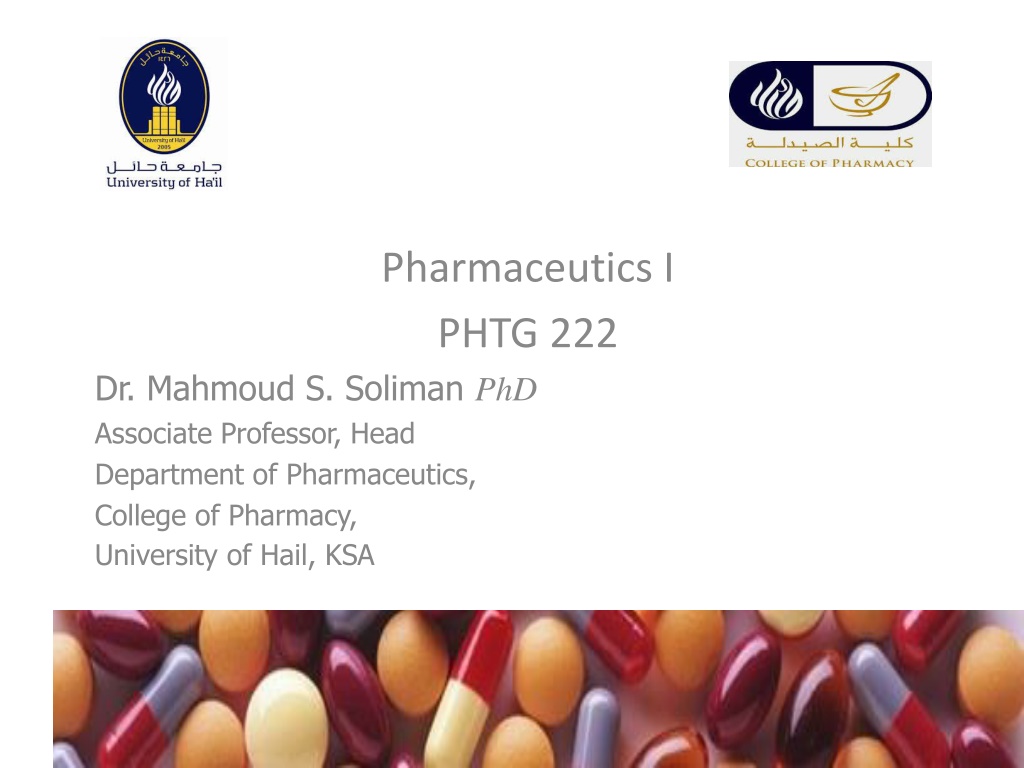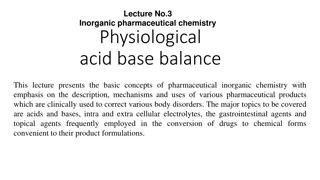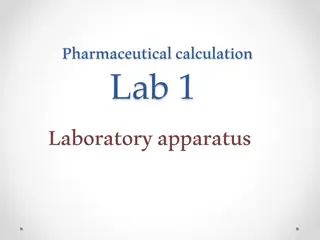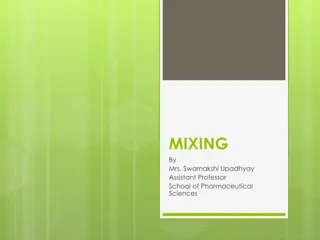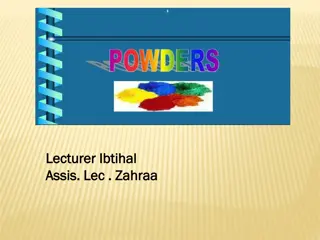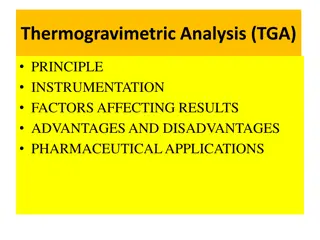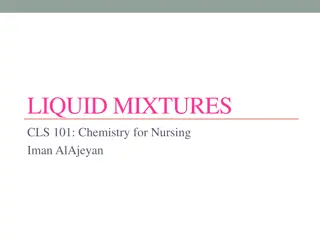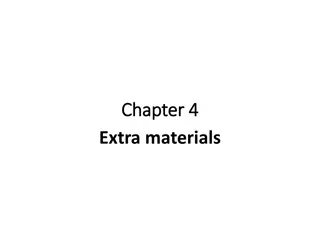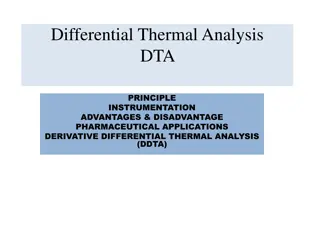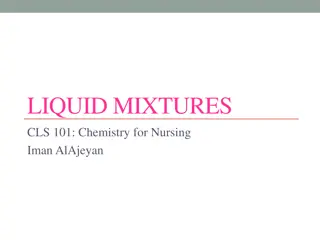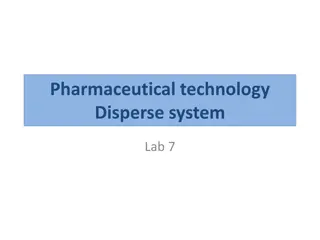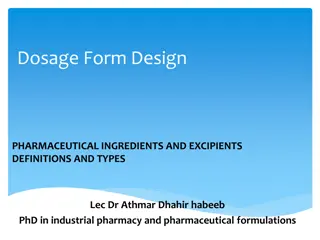Pharmaceutical Suspensions: Definition, Formulation, and Applications
Pharmaceutical suspensions are dispersions of insoluble solid particles in a fluid medium, commonly aqueous. They offer benefits like increased drug stability, improved palatability, and ease of administration. Formulation considerations include homogeneity, re-suspension ability, particle size, and viscosity control. This article delves into the reasons for using suspensions in pharmaceuticals and key properties of well-formulated suspensions.
Download Presentation

Please find below an Image/Link to download the presentation.
The content on the website is provided AS IS for your information and personal use only. It may not be sold, licensed, or shared on other websites without obtaining consent from the author. Download presentation by click this link. If you encounter any issues during the download, it is possible that the publisher has removed the file from their server.
E N D
Presentation Transcript
Pharmaceutics I PHTG 222 Dr. Mahmoud S. Soliman PhD Associate Professor, Head Department of Pharmaceutics, College of Pharmacy, University of Hail, KSA
Pharmaceutical Suspensions Definition Is a dispersion of finely divided, insoluble solid particles (the dispersed phase) in a fluid (the dispersion medium). Most pharmaceutical suspensions are aqueous, but an oily vehicle is sometimes used.
Physical properties of a well-formulated suspension 1. Remain sufficiently homogenous at least for the period between shaking the container and removing the required dose. 2. Sediment formed on storage must be easily re-suspended by moderate shaking. 3. Viscosity must not be so high to be easily removed & applied not so low to reduce the rate of settling of the particles 4. Suspended particles must be small & with uniform size to give smooth & elegant product free from a gritty texture.
Reasons for suspension formulation Suspension may be used pharmaceutically for a number of reasons: 1. For drugs that have very low solubility. 2. To increase chemical stability Some drugs are chemically unstable in solution but stable when suspended e.g. Oxytetracycline in aqueous solution Oxytetracycline HCl salt is soluble and hydrolyzed rapidly in aqueous medium (less stable). Oxytetracycline calcium salt is insoluble and is stable in aqueous medium.
Reasons for suspension formulation Suspension may be used pharmaceutically for a number of reasons: (N.B) If the drug is unstable when in contact with the vehicle, suspension should prepared immediately prior to handling out by the patients in order to reduce the amount of time that the drug particles are in contact with the dispersion medium. e.g. Ampicllin suspension, water is added to powder or granules prior to giving out to the patients.
Reasons for suspension formulation 3. To increase drug palatability Some drugs have unpleasant taste in their soluble form their formulation into insoluble derivatives (suspension) makes them more palatable. e.g. Paracetamol suspension is more palatable than paracetamol solution. 4. Ease of swallowing liquids and the flexibility in administration of a range of doses, compared to solid dosage forms.
Reasons for suspension formulation 5. Intramuscular or S.C. injections are formulated as suspension to prolong the release of the drug. 6. Lotions containing insoluble solids, are formulated to leave a thin coating of the drug on the skin So as the vehicle evaporate it gives a cooling effect and leaves the solid behind. e.g., Calamine lotion.
Pharmaceutical applications of suspensions: Suspensions can be used as 1 - Oral suspensions 2 - Reconstitutable suspensions. 3 - Parenteral suspensions. 4- Topical and cosmetic suspensions. 5- Suspensions for inhalation.
Pharmaceutical applications of suspensions: 1. Suspensions as oral drug delivery systems For people have difficulty in swallowing solid dosage forms such as pediatrics and geriatrics. To facilitate drug absorption and/or therapeutic activity. Some drugs are required to be present in the gastrointestinal tract in a finely divided forms their formulations as suspensions will provide the desired high surface area for enhanced absorption/therapeutic activity. e.g. Kaolin, magnesium carbonate and magnesium trisilicate are used for the adsorption of toxins, or to neutralize excess acidity.
Pharmaceutical applications of suspensions: 1. Suspensions as oral drug delivery systems To increase drug palatability Some drugs have unpleasant taste in their soluble form their formulation into insoluble derivatives (suspension) makes them more palatable. e.g. Paracetamol suspension is more palatable than paracetamol solution.
Pharmaceutical applications of suspensions: 2 Reconstitutable suspensions. Provided as a mixture of dry powders to be reconstituted immediately before use. Once reconstituted, they have limited shelf-lives (weeks) Used for unstable drugs. e.g. Dry powder of pediatric antibiotics can stay for long shelf-life, but when formulated as suspension used for 15 days.
3- Parenteral suspension Parenteral suspension are commonly used for controlling the absorption rate of the drug. If the drug is suspended in a fixed oil such as arachis or sesame, the product will remain after injection in the form of an oil globule, thereby presenting to the tissue fluid a small surface area from which the partitioning of drug can occur.
Pharmaceutical applications of suspensions: 4- Suspensions for topical administration They are fluid preparations, such as Calamine Lotion, which are designed to leave a light deposit of the active agent on the skin after quick evaporation of the dispersion medium. 5- Suspensions for inhalation For drugs unstable in GIT Rapid therapeutic effect No first pass metabolism Low doses (few side effects)
Formulation of suspensions I) Particle size control. II) Wetting the particles. III) Promotion of flocculation. IV) Viscosity Modification. V) Formulation additives.
I- Particle size Control The rate of sedimentation of suspended particle can be retarded by reducing its size. The initial velocity at which particles in a suspension settle is by Stokes' law: V = d2( 0) g / 18 0 where V: the velocity of sedimentation of suspended particles in the suspension D: the mean particle diameter : the density of the particles (dispersed phase) 0 : the density of the medium (dispersion medium) g: the acceleration constant associated with the force of gravity 0: the viscosity of suspension medium.
I- Particle size Control V = d2( 0) g / 18 0 From Stokes' low; V is proportional to d2 1. As the particle size increased rate of sedimentation of suspended particles increased. 2. The greater the difference in density between the particle and the vehicle the greater will be the rate of sedimentation. 3. Increasing the viscosity of dispersed medium reduce the rate of sedimentation.
Importance of particle size control Large particles, if greater than about 5um diameter may cause irritation if injected or instilled into the eyes. The ease of administration of a parenteral suspension may depend upon particle size and shape and it is quite possible to block a hypodermic needle with particles over 25 um diameter.
II- Wetting the particles Wetting the particles The initial dispersion of the particles in a suspension represents the first important step in the manufacturing process. Wetting; is substitution of solid air interface by solid liquid one. The insoluble drugs may be; a) Lyophilic (solvent-loving powders or diffusible solids) b) Lyophobic (solvent-hating powders or indiffusible solids)
II- Wetting the particles Lyophilic Powders Lyophobic Powders Diffusible solids Indiffusible solids Easily wetted by water Not easily wetted by water but form large porous clumps and float on the surface of the vehicle. Stay dispersed long enough for not stay dispersed long enough for an adequate dose to be measured adequate dose to be measured. After settling they re-dispersed easily Not re-disperse easily after settling. e.g. Calamine, sulphur, magnesium e.g.,Magnesium tri-silicate; Light Mg stearate and zinc oxide carbonate , Talc and Bismuth carbonate.
II- Wetting the particles Wetting of particles can be achieved by using Wetting agents such as 1. Hydrophilic colloids: e.g. Gum acacia, gum Tracaganth, bentonite, alginates and cellulose derivatives 2. Surface active agents (Surfactants): a) For oral use: Polysorbates (Tweens), Sorbitan fatty esters (Spans). b) For external use: Sodium lauryl sulphate. c) For parenteral administration:polysorbates (Tweens) and lecithin. 3. Solvents: e.g. Ethanol, glycerol and glycols.
III- Promotion of flocculation According to the rate of suspended particles (dispersed phase) sedimentation, suspensions are classified into: A) Flocculated B) Deflocculated
3- Promotion of flocculation: In deflocculated suspension The individual particles have similar charges and the repulsive forces between them give slow rate of settling and the sediment becomes compacted and can be very difficult to redisperse This phenomenon is also called caking or claying and is the most serious of all the physical stability problems encountered in suspension formulation. In flocculated suspension The individual particles are of mixed charges, thus attraction between them will tend to collect into flocs and flocculated suspension is produced. Aggregation of particles in a flocculated system will lead to a much more rapid rate of sedimentation because each unit is composed of many individual particles and is therefore larger. The sediment is composed of loose or "fluffy" floccules of higher porosity, the volume of the final sediment will still be large and will easily be redispersed by moderate agitation.
III- Promotion of flocculation Flocculated Suspension Deflocculated Suspension Suspended particles are of mixed charges Suspended particles have similar charges attraction between them Particles form repulsion exist as separate entities loose aggregates (flocs) High sedimentation rate Slow sedimentation rate Sediment is Sediment is formed rapidly formed slowly loosely packed closely packed Does not form hard cake Form hard cake The sediment is easily re-dispersed The cake is difficult to re-disperse The volume of sediment is large The volume of sediment is small Clear supernatant The supernatant is cloudy
Flocculating Agents Deflocculated suspension are converted to flocculated suspension by addition of Flocculating agent such as: A) Electrolytes B) Surfactants C) Hydrophilic polymers. 1- Electrolytes 2- Surfactants Deflocculated suspension Flocculated suspension OR 3- Hydrophilic polymers
A. Electrolytes The most widely used electrolytes include the sodium salts of acetates, phosphates and citrates, and the Concentration chosen will be that which produces the desired degree of flocculation. Care must be taken not to add excessive electrolyte or charge reversal may occur on each particle, so forming, once again, a deflocculated system.
Flocculating Agents A) Electrolytes electrolytes act by decreasing zeta potential flocculation occur. E.g., Suspension of Bismuth subnitrate in water particles have large - ve charge (large zeta potential) i.e., Strong repulsion between particles so suspension is deflocculated (peptized). Addition of monobasic potassium phosphate (flocculating agent) decrease zeta potential then with continued addition of the flocculating agent, the Zeta potential fall to Zero then increase in negative direction. Addition of electrolytes will decrease Zeta potential allow the formation of loose aggregation (Flocculation). Addition of excess flocculating agent will neutralize all the charges on the particles the particle will carry the same charge as the flocculating agent deflocculation & caking occur.
Flocculating Agents B) Surfactants 1. Ionic surface-active agent Act by neutralizing the charge on each particle flocculation. 2. Non-ionic surfactants Neutral, linear structure Act by adsorbing more than one particle on their surfaces forming a loose flocculated structure.
Flocculating Agents C) Polymeric flocculating Agents Their linear branched structure form a gel-like network adsorbed onto the surfaces of the dispersed particles flocculation. E.g., Starch, alginates, cellulose derivatives, tragacanth, carbomers and silicates
IV- Viscosity Modification Why we need to modify the viscosity in suspension formulation?? 1- Viscosity can affect settling of the suspended articles. 2- Viscosity can change the flow properties when container is shaken or product pour from the bottle. 3- Viscosity can affect spreading of topical products applied to skin. Suspending agents increase the viscosity of the vehicle slow down sedimentation. The Ideal Suspending Agent 1- Have a high viscosity during shelf storage, i.e., at low shear. 2- Have a low viscosity at high shearing rate, i.e., it should be free-flowing during agitation, pouring, and spreading.
IV- Viscosity Modification Classification of Suspending Agents 1. Natural polysaccharides: e.g. Tragacanth, acacia, starch . 2. Semi-synthetic polysaccharides: e.g. Cellulose derivatives such as methyl cellulose , Hydroxymethyl cellulose, sodium carboxy methyl cellulose . 3. Clays: natural inorganic materials which are mainly hydrated silicates, e.g. Bentonite, Magnesium aluminium silicate. 4. Miscellaneous compounds: e.g. Gelatin.
V- Formulation Additives 1- Buffers Buffers are used to maintain chemical stability or to ensure physiological compatibility. 2-Density modifiers From Stokcs' law if the dispersed and continuous phases have the same densities SO sedimentation would not occur. Minor modification to the aqueous phase of a suspension by incorporating sucrose, glycerol or propylene glycol can be achieved to modify the density of the dispersion medium.
V- Formulation Additives 3-Humectants: They are used to prevent drying out of the product after application to the skin. e.g. Glycerol and propylene glycol 4- Preservatives: To prevent the growth of micro-organisms which may be present in the raw material and/or introduced into the product during use. e.g. Benzoic acid (oral use) Methylparahydroxybenzoate (methyl paraben, for oral & external use). Chlorocresol (external use).
V- Formulation Additives 5-Flavors, Colors and Perfumes Colorings and flavorings are added to suspensions. To increase patient palatability and acceptance. 6- Sweetening agents: Sucrose is the most widely used sweetening agent. Artificial sweeteners e.g., saccharin and Aspartame But all artificial sweeteners give a bitter or metallic after-taste, so used with sugars to mask this.
Evaluation of Suspensions Sedimentation parameters Pharmaceutical suspensions are evaluated by calculating Sedimentation parameters which include: 1- Sedimentation volume F 2- Degree of Flocculation .
Evaluation of Suspensions 1- Sedimentation Volume F Sedimentation volume (F) is the ratio of the final volume of the sediment (Vu) to the original volume of the suspension (Vo) before settling. F = Vu/Vo F values range from less than 1 to greater than 1. The sedimentation volume gives only a qualitative account of flocculation.
Evaluation of Suspensions F = Vu/Vo 1- Sedimentation Volume F c -150 -150 -150 b a -100 -100 -100 -50 -50 -50 F = 0.5 i.e., Vu< Vo F = 1 i.e., Vu= Vo F = 1.5 i.e., Vu> Vo Flocculation equilibrium No clear supernatant on standing. Flocs formed are so loose and fluffy a greater volume than the original volume of suspension
Evaluation of Suspensions 2- Degree of Flocculation If we consider a suspension that is completely deflocculated the ultimate volume of the sediment will be relatively small. Writing this volume as V F = V / Vo Where F : the sedimentation volume of the deflocculated suspension V : ultimate volume of deflocculated suspension In case of flocculated suspension F = Vu/Vo
Evaluation of Suspensions 2- Degree of Flocculation The degree of flocculation, , is defined as the ratio of F to F = F/F Thus = (Vu/ Vo) / V / Vo= = Vu/ V The degree of flocculation is a more useful parameter than F since it relates the volume of flocculated sediment to that in a deflocculated system.
Packaging and Storage of Suspensions All suspensions should be packaged in wide mouth containers having adequate airspace above the liquid to permit thorough mixing by shaking and ease of pouring. Most suspensions should be stored in tight containers protected from freezing, excessive heat and light. t is important that suspensions be shaken before each use to ensure a uniform distribution of solid in the vehicle and thereby uniform and proper dosage.
Examples of Pharmaceutical Suspensions Oral Suspension Drug Concentration In Commercial Product Comments Antacids Aluminum hydroxide,200 mg; Magnesium hydroxide, 200 mg; simethicone, 20 mg/5mL Counteract gastric hyperacidity, relieve distress in GIT Alumina, magnesia, simethicone Anthelmintics Pyrantel pamoate 250 mg/5 mL For worm infestations Antibacterials (Antibiotics) Ciprofloxacin 50 and 100 mg/mL Indicated in the treatment of specific susceptible microorganisms Antidiarrheal Bismuth subsalicylate 262 mg/15 mL for prevention and treatment of diarrhea Antiflatulent Simethicone 40 mg/0.6 mL Symptomatic treatment of GIT distress due to gas. Antifungals Nystatin 100,000 U/mL Treatment of mouth infections caused by Candida albicans NSAIDs 25 mg/5 mL Active treatment of moderate to severe rheumatoid arthritis Indomethacin
